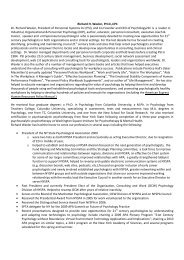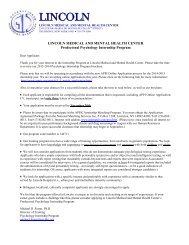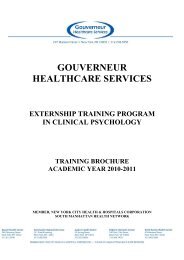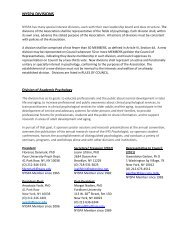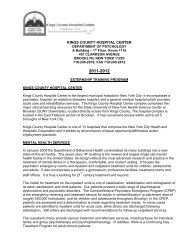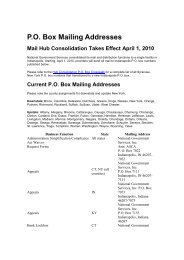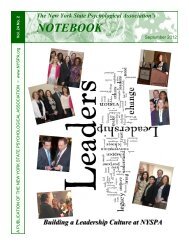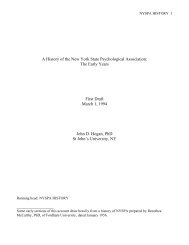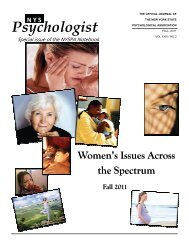Abridged Guidelines for Parliamentary Procedure - New York State ...
Abridged Guidelines for Parliamentary Procedure - New York State ...
Abridged Guidelines for Parliamentary Procedure - New York State ...
You also want an ePaper? Increase the reach of your titles
YUMPU automatically turns print PDFs into web optimized ePapers that Google loves.
4process of amending the motion to reach the agreed <strong>for</strong>m. The in<strong>for</strong>mal procedure ofgeneral consent may be used. When the group opinion has been crystallized thepresiding officer may announce “If there is not objection we will . . .”. A singleobjection <strong>for</strong>ces a vote.When time is limited, problems are pressing, and action is required, the use ofparliamentary procedure is recommended.Motions:A motion is a <strong>for</strong>m of expression, usually beginning with the words “I move that…”Used to present ideas to a group <strong>for</strong> consideration. The term precedence refers to therank of a motion in an established, or agreed upon order <strong>for</strong> motions.The Precedence of Ordinary Motions:1. To Adjourn2. To Recess3. To Close Debate4. To Limit (Extend the Limits of) Debate5. To Postpone6. To Refer7. To AmendThe motion to Adjourn has the highest rank or precedence. This means that ToAdjourn is in order even though other motions are pending. On the other hand, a motionof low precedence, or rank, may not be made if one of higher rank is under consideration.A main motion has the lowest rank of all. Most of the seven ordinary motions exist tofacilitate the ef<strong>for</strong>ts of an assembly to arrive at a decision on a main motion.Special Motions:Point of OrderTo AppealTo WithdrawTo Suspend the RulesTo ReconsiderTo RescindSpecial motions have no rank in relation to each other; no necessary or predefinedrelationship. Except <strong>for</strong> To Reconsider and To Rescind, they exist largely to handleprocedural matters that arise during the consideration of a main motion, and must bedecided immediately.4
5Thus, in addition to the main motion, there are seven ordinary motions and six specialmotions. Only three of the thirteen require a two-thirds vote: To Limit (Extend the Limitof ) Debate, To Close Debate, and To Suspend the Rules. All others need only a majorityvote to pass.A point of order is a request or demand, not a motion. To Withdraw and To Suspendthe Rules are not debatable. Only one special motion, To Rescind, may be amended.Seconding of Motions:Motions need not be seconded. The requirement of a second is largely a waste oftime. There is nothing wrong with the practice of seconding. It is simply unnecessary.When a motion is made, the presiding officer, without asking <strong>for</strong> a second, shouldeither state the motion or rule it out of order. The presiding officer should rule frivolousand dilatory motions out of order.Quorum:This is the minimal number of members of the legislative body who must be present inorder to conduct business legally. The number constituting a quorum is defined in theorganization’s bylaws. The Presiding officer verifies the presence of a quorum be<strong>for</strong>e themeeting may be called to order by requesting a report on the status of a quorum by thesecretary or parliamentarian. Only certain actions may be taken if no quorum is present.These include To Adjourn, To Recess, to set a time <strong>for</strong> the next meeting, or to take actionto secure a quorum. Also, committee reports may be heard, but no action taken on them,remarks of members and others may be listened to, and emergency action may be takenwith the need to have it approved at a later meeting with a quorum present. If a quorumis no longer present due to a member’s departure (“disappearing quorum”) the presidingofficer must either close the meeting or limit the group to those actions permissible in theabsence of a quorum (discussed above). The question of a “disappearing quorum” maybe raised at any time, except to interrupt a speaker; a member rises and, withoutnecessarily waiting <strong>for</strong> recognition from the presiding officer, states, “Mr. Chairperson, Iquestion the presence of a quorum.” The presiding officer then must determine if aquorum is present and respond appropriately.It is too late to invalidate an action after intervening business has been conducted,even if the absence of a quorum is then determined. The law presumes the continuingpresence of a quorum if the meeting begins with one, and regards all action taken as legalunless evidence clearly shows the absence of a quorum at the time of voting. When ameeting starts without a quorum present any business transacted will be unofficial andinvalid.When meetings are required as scheduled in the bylaws, the absence of a quorum doesnot invalidate compliance with the rules. The meeting was held, quorum or no quorum,5
6and need not be rescheduled to comply with the requirement of a legal meeting. Themeeting is legal; the conduct of most business without a quorum is not.Organizations should state in their bylaws the requirements <strong>for</strong> a quorum, includingthat <strong>for</strong> standing committees, otherwise a quorum is assumed to be a majority of themembership.A clearly worded agenda should always be distributed prior a meeting being held.This agenda should include the names of any speakers.The Main Motion:A Main Motion is the statement of a request <strong>for</strong> action, an idea <strong>for</strong> evaluation, or theintroduction of a resolution stating the group’s position on a subject. It should be statedin the affirmative. A main motion is debatable, it may be amended, it almost alwaysrequires a majority vote to pass, and the vote may be reconsidered. To prevent confusion,only one main motion may be considered at a time.Examples: I move that Executive Council authorize a donation of twenty dollars <strong>for</strong>the Red Cross.ORDINARY MOTIONS:To Amend:Resolved that this Association expresses its appreciation to Dr. Jill Jones<strong>for</strong> her donation to the development fund.An amendment is a change in the wording of a amendable motion, usually a mainmotion, to make it express more accurately what the majority wants it to say, be<strong>for</strong>e it isvoted on. To amend is debatable, amendable, and requires a majority vote.Examples: I move to delete all after “Tuesday morning” in the motion.I move to add to the motion the words “at the discretion of the President.”The following ordinary motions may be amended:To Amend – if the change proposed is accepted without <strong>for</strong>mal motion and vote.To Refer – as to size of committee, selection process, deadline <strong>for</strong> report, etc.To Postpone – as to the limits of postponement.To Limit (Extend the Limits of) Debate – as to number of speakers.To Recess – as to duration of recess.One may not amend an amendment. The amendment is voted on. If passed, a newamendment may be proposed to the then existing main motion. Thus, only one proposedamendment is pending at a time.6
7An amendment should not be at odds with the general intent of the main motion. Withapproval by majority vote a substitute motion, that is a motion replacing the main motion,proposed as an amendment may be passed. No motion previously passed may beamended by a lesser vote than was required to pass the main motion originally.To Refer:The motion to refer is almost always used to send the consideration of a main motionto a committee. To refer a motion to a hostile committee in order to kill it is not alegitimate use of referral. This motion is debatable, may be amended as to the number onthe committee, the selection process, instructions to the committee, etc., and requires amajority vote to pass.Example: I move we refer the consideration of the motion that [stating mainmotion] to a committee of three, appointed by the chair, to report atour next meeting.To Postpone:The motion To Postpone, if passed, removes a subject from consideration until thetime or meeting specified in the motion To Postpone. It is debatable, may be amended asto time or conditions of postponement, and requires a majority vote to pass. It applies tomain motions only. It is the consideration of the motion that is postponed, not the motionitself. To postpone consideration of a motion until meaningful action is impossible, inorder to kill the motion, is not a proper use of the motion To Postpone. Proposedamendments to the main motion are postponed if consideration of the main motion ispostponed. To Postpone is not in order if motions of a higher rank are pending.To Limit (Extend the Limit of) Debate:The purpose of this motion is to permit an assembly to control discussion of a motionby setting limits on the time allowable <strong>for</strong> discussion be<strong>for</strong>e voting on the pendingmotion. It is not debatable. It is amendable as to the specific time limits involved. SinceTo Limit Debate may infringe on the basic principle of freedom of discussion, a twothirdsvote is required to pass. Motions to limit debate are implemented by the presidingofficer, who announces when the limit has been exhausted and proceeds to call <strong>for</strong> a voteon the immediately pending motion.Example: I move to Limit Debate to three speakers <strong>for</strong> each side of the question,each to speak no longer than five minutes.To Close Debate:When a motion To Close Debate is passed, all discussion on the pending motion(s) isterminated, and the assembly proceeds to vote on the immediately pending motion, unless7
8a motion of higher rank such as To Adjourn, intervenes. After the vote has been taken,its effect has been exhausted. To Close Debate is not debatable and requires a two-thirdsvote to pass. It should not be entertained by the presiding officer (whose decision may beappealed and reversed) if a fair opportunity to discuss he motion has not been given to allinterested members. This motion should be used infrequently , but is effective instopping filibustering and other dilatory tactics.To Recess:Example: I move To Close Debate on all pending debatable motions (mainmotion, a proposed amendment, To Refer, and To Postpone, dependingon what is pending at that time).To Recess is a motion to interrupt a meeting. It is useful to provide a brief rest periodin a tiring session, to break <strong>for</strong> a specific purpose (count ballots, etc.) or to continue ameeting on another day, while also stipulating a definite time to reconvene the meeting.To Recess is not debatable, it may be amended as to the time limit of the recess, and itrequires a majority vote to pass. To Recess is in order provided the motion To Adjourn isnot pending. The motion To Recess is in order as a main motion in the absence of aquorum and may be used to await the presence of a quorum. To Recess provides <strong>for</strong> aninterval in the meeting, not an adjournment. When called to order after a recess the groupresumes its considerations of the point at which it was interrupted.To Adjourn:Example: I move to recess until the ballots have been counted.Adjournment is the termination of a meeting, with the next meeting to be heldfollowing a call <strong>for</strong> a new meeting. To Adjourn is the highest ranking ordinary motion.To Adjourn is in order as a main motion in the absence of a quorum. It is neitherdebatable nor amendable and requires a majority vote to pass.Example: I move that we adjourn until April 17 at 4:00pm.If the agenda <strong>for</strong> a meeting has been completed and no one wants the floor, thepresiding officer should adjourn the meeting by announcing “Since there is no furtherbusiness, if there is no objection, the meeting is adjourned.” If there is unfinishedbusiness at the time of adjournment, such items are carried <strong>for</strong>ward to the next meeting asunfinished business.SPECIAL MOTIONS:Point of Order:A point of order is the procedure followed to call the attention of the presiding officerto a violation of the rules, an omission or a mistake in the proceedings, or any unusual8
9situation requiring immediate attention. A Point of Order is not debatable, notamendable, and requires no vote since the presiding officer decides the point at issue. Itis in order at any time. A member may appeal the ruling of the presiding officer. Thepresiding officer may refer the decision to the assembly <strong>for</strong> a decision by majority vote.To Appeal:Example: Member: Mr. President, I rise to a Point of Order.President: <strong>State</strong> your point.Member: We have two main motions on the floor.President: Your point is well taken. We shall consider only (stating themotion) at this time.orThe only main motion now under consideration is (statingmotion). There<strong>for</strong>e, your point is not well taken.To Appeal the ruling of the presiding officer means to subject her or his ruling toexamination by the assembly and to secure its support or reversal. The purpose of thismotion is to monitor the appropriateness and accuracy of the presiding officer’s rulingsand to prevent the arbitrary exercise of power. To Appeal is debatable and may not beamended, postponed, or referred to a committee. To be in order, an appeal must be raisedimmediately after the ruling in question is made by the presiding officer. The mover mayinterrupt a speaker to do so.The affirmative vote to support the ruling is requested first, followed by the negativevote to reverse the ruling. A majority vote in the negative is required to overrule theruling of the presiding officer, a tie vote sustains the ruling of the presiding officer.Example: Member: Ms. President, I appeal from the ruling of the chair that (statingthe decision).President: The ruling of the chair that (stating the ruling in question) hasbeen appealed from. Will the member please state his reasons<strong>for</strong> appealing?Member: (<strong>State</strong>s his reasons).President: (<strong>State</strong>s reasons <strong>for</strong> supporting ruling). Is there any otherdiscussion on the motion? Are you ready to vote?President: Those in favor of accepting the ruling of the chair that (statingthe ruling) please hold up their right hand. Those opposed, thesame sign. Thank you. The ruling of the chair is upheld by avote of 21 to 9.orThe ruling of the chair is reversed by a vote of 10 in favor and14 opposed, and the judgement of the assembly is that (statingthe decision of the assembly).9
10To Withdraw:To withdraw a motion is to remove it from consideration. The purpose of ToWithdraw is to provide a means <strong>for</strong> terminating consideration of a motion withoutactually voting on it. It is not debatable, not amendable, and requires a majority to pass.This may be done any time prior to the final vote on the motion.A motion that has been withdrawn after having been stated by the presiding officer isrecorded by the secretary with a statement that it was withdrawn.Example: Member: Mr. President, I request permission To withdraw my motion(stating motion).President: The motion that (stating motion) is withdrawn.To Suspend the Rules:To Suspend the Rules is to set aside or make inoperative in a given situation a rule o<strong>for</strong>der that would otherwise prevent the assembly from taking a desired action. Its purposeis to allow an organization to violate its own rules or procedure when the circumstanceswarrant. It is not debatable, not amendable, and requires a two-thirds vote to pass. Onlyprocedural rules may be suspended; it does not apply to bylaws or the constitution of theorganization. Members may not be deprived of their rights by suspending the rules. Theadopted parliamentary authority may not be suspended, although it may be changed byamending the bylaws.Example: Member: Madam President, I move To Suspend the rules to hear the reportof the Ethics Committee be<strong>for</strong>e the report of the FinanceCommittee, out of order on the agenda, so that the Ethics Chairmay attend another meeting.President: If there is no objection (pausing) the rules will be suspended topermit….To Reconsider:To Reconsider is to call back <strong>for</strong> further consideration by the assembly an actionpreviously taken on a main motion. It is debatable, not amendable, and requires amajority vote to pass. Its consideration may not be referred to a committee or postponed;it is valid only in the same meeting in which the original motion was made. ToReconsider must be made while another main motion is pending, but its consideration isdelayed until three is not another main motion pending. It is used to reconsider adecision made under a misapprehension or with inadequate in<strong>for</strong>mation. No vote on amain motion may be reconsidered, however, if some irreversible action has already beentaken on it, such as a payment of money, signing of a contract, a notification of anappointment and acceptance by the party concerned.10
11Example: Member: Mr. President, I move To Reconsider the vote that we contribute$100 to the campaign of Senator Wilson.President: A motion To Reconsider the vote on the motion (states it) isbe<strong>for</strong>e you <strong>for</strong> discussion. Since no action was taken on thisdecision the floor is now open <strong>for</strong> discussion of the motion.To Rescind:To Rescind is to nullify a decision or action that cannot be changed by a motion ToReconsider. Its purpose is to cancel, or make void, the results of a motion previouslypassed. To Rescind is a main motion, in order only when no other main motion ispending. It is debatable, may be amended (only as to the motion of the decision to berescinded) and requires a majority vote to pass. It makes no difference how ling ago themain motion to be rescinded was passed. Motions may not be rescinded, however, ifirreversible actions have already been taken on them. However, unexecuted portions of amotion may be rescinded. Advance notice is required <strong>for</strong> a majority vote to pass; a twothirdsvote is required is no advance notice is given.Example: Member: Mr. President, I move To Rescind the decision taken at our lastmeeting that our annual convention be held at the newconvention center.President: A motion To Rescind the decision taken in the last meeting thatour annual convention be held in the new convention center isbe<strong>for</strong>e you <strong>for</strong> discussion.(If passed): The motion To Rescind the decision taken in the lastmeeting that our annual convention be held at the newconvention center is passed. There<strong>for</strong>e, that action no longerstands. The next item on the agenda is….CONDUCTIG THE MEETING:Role of the Presiding Officer:The presiding officer should remain impartial in making rulings and grant eachmember equal rights regardless of positions taken on the issues. Whenever the presidingofficer rules a motion out of order s/he should explain why it is out of order, and advisethe mover when it would be in order, or how the mover’s intent, if known, might beaccomplished by the use of another procedure.The Order of Business:Organizations should adopt, and include in their rules of order, a systematic plan <strong>for</strong>considering items in meetings. Such a plan is traditionally referred to as the order ofbusiness or agenda.11
12Example: 1. Presentation of minutes.2. Reports of officers, boards, and standing committees.3. Reports of special committees.4. Unfinished business.5. <strong>New</strong> business.Changing the order of business, when desired, may be accomplished by a motion toSuspend the Rules.Recognition of Speakers:The presiding officer must be fair in recognizing speakers in debate. As a rule, thepresiding officer should allow <strong>for</strong> alternation of speakers pro and con on motions underconsideration. S/he should be ready to refuse firmly to recognize members who claim thefloor a second or third time be<strong>for</strong>e others have had their first turn to speak.Disciplinary Measures:An organization has the authority to control its own meetings and to determine who, ifanyone, may be present other than its own members. If desired, a motion To Go IntoExecutive Session may be made. It may not be amended and requires a majority vote topass.Members who are out of order or are disruptive during a meeting should be given twoverbal warnings. If unheeded, the presiding officer may invite a motion to censure theoffending member, explaining that this becomes a matter of record in the minutes of theorganization. This motion is debatable and requires a two-thirds vote to pass.The presiding officer alone has no authority to discipline members but may conductthe procedures <strong>for</strong> disciplining members at the direction of the assembly.Voting <strong>Procedure</strong>s:As a member of the group, the presiding officer has the same right to vote as any othermember. However, it is probably wise <strong>for</strong> the presiding officer to vote only in cases inwhich a vote is needed to change the outcome.The presiding officer states each motion, asks <strong>for</strong> discussion, restates each motion,asks <strong>for</strong> a vote, then restates the motion as carried. All of these steps are essential <strong>for</strong>clarity.Participating Members:Members will abide by decisions of the chair (unless an appeal is in order), refrainfrom discrediting individuals when they should be attacking arguments, exercise courtesy12
13towards others, be restrained in language and action, and cheerfully (on the surface, atleast) work to implement a majority decision even if they voted with the minority.The Secretary:The secretary keeps the official record. S/he provides all members with a copy of theagenda, the minutes of the previous meeting, committee reports, if available, and a list ofunfinished business. The minutes include a record of all official actions taken, thepresiding officer, the presence of a quorum, and in<strong>for</strong>mation showing that the meetingwas duly called and thus, legal.The exact statement of motions passed should be recorded, the names of participantsin the discussion of the motion need not be. It is desirable to include in the minutes themajor arguments <strong>for</strong> and against a motion, but these should not be identified withspeakers. The official record of actions taken is recorded, not a transcript of whatindividuals say in meetings.Complete records must be kept of all referrals, postponements, and appeals;amendments need not be entered. If the secretary is a member of the organization s/hehas the same right to present, discuss, and vote on motions as any other member.The Parliamentarian:The parliamentarian advises the presiding officer on parliamentary procedure. Sheshould be appointed by the presiding officer, not elected. S/he must be an objective andimpartial advisor. The parliamentarian gives advice on procedure when requested by thepresiding officer. The parliamentarian does not answer questions by addressing theassembly, except at the invitation of the presiding officer. S/he does not make rulings,only the presiding officer may do so.Organizations should spell out in their bylaws the function, conditions of appointment,term of office, procedures <strong>for</strong> filing vacancies, and the like concerning theparliamentarian.COMMITTEES:Standing Committees are provided <strong>for</strong> in the bylaws of the organization. Specialcommittees are those appointed or elected to do a particular job; they cease to exist whenthey have completed their assigned task and have reported to the assembly.Selection of Members:Ordinarily, the committee should be representative of the overall organization. Itsmembers should represent various interest groups, geographical areas, etc. To prevent atie vote, most committees should be composed of an odd number of members.13
14“Ex Officio” membership usually confers all the privileges of other committeemembers, including the right to vote, but not the obligation to attend meetings regularly.There<strong>for</strong>e, unless present, an “ex officio” member should not be counted in determining aquorum. A majority of a committee’s members must approve its final report be<strong>for</strong>e itmay be submitted to the assembly. A minority report may also be submitted to theassembly.Presentation and Consideration of Reports:The organization’s presiding officer calls <strong>for</strong> a committee report by announcing thatthe report of the (naming the committee) will be presented at this time. The committee’sPresiding officer should already have provided the secretary with a copy of thecommittee report. If it is long, it should be duplicated and distributed to the memberswith the call <strong>for</strong> the meeting. Following the discussion, if any, the presiding officer ofthe organization should announce, “Since no action is required, the report will be filed.”To file a committee report commits the assembly to nothing. To adopt a reportcommits the assembly to approval of opinions and activities described, but does notauthorize implementation of the proposed recommendations. The committee’srecommendations must be presented as main motions and then voted on. With longdocuments, a vote is taken on the adoption of one paragraph at a time.In<strong>for</strong>mation on Committees in the Bylaws:All standing committees should be named in the constitution or bylaws. For each, thefollowing should be provided:1. Number of members, and number constituting a quorum.2. Special qualifications, if any, <strong>for</strong> membership.3. Selection process <strong>for</strong> members.4. Selection process <strong>for</strong> the presiding officer.5. Terms of office, including provision <strong>for</strong> “staggering,” if desired.6. Function.7. Provision <strong>for</strong> filling vacancies.8. Frequency and time of reports.The bylaws should also authorize the president or the assembly to create specialcommittees to accomplish particular tasks. The structure of special committees cannot beset <strong>for</strong>th in the bylaws since it will depend on the purpose and nature of the committee.VOTING:A majority vote is a majority of eligible votes cast, not counting blanks andabstentions. A unanimous vote should mean that all members present and eligible to votedid so, and that all voted the same way. A two-thirds vote means two-thirds of heeligible votes were cast. A tie vote is considered a negative vote, not a deadlock.14
15Methods of Voting:In a vote by general consent, the presiding officer declares a motion passed or arequest granted “if there is no objection.” This procedure is used widely to securedecisions on routine, noncontroversial questions. Other methods of voting include: thevoice vote, the show of hands, the rising vote, the roll call, by ballot, the mail vote, thevote by proxy, and preferential voting (Hare System).NOMINATIONS AND ELECTIONS:Canvassing the ballots means more than just counting. It includes evaluating ballotsto identify those that are invalid blank, cast by illegal nominees, illegible, abstaining, andthe like, and reporting the results to the presiding officer <strong>for</strong> his/her announcement of theresults.A listing of all officers and eligibility qualifications, duties, and terms of office <strong>for</strong>each should be listed on the bylaws.The use of preferential balloting makes only one ballot necessary. Nominations maybe made by a nominating committee, appointed or elected as described in the bylaws, orby petition, also spelled out in the bylaws.A vote by ballot is usually taken to mean that voting is conducted so as to preventdisclosure of the members' vote. Errors in spelling do not make a ballot invalid of theintent of the voter is obvious.CONSTITUTION, BYLAWS, AND RULES:See attached example in Appendix One.A constitution always includes a procedure by which the constitution may beamended, stipulating how much advance notice is require and by how large a vote(usually two-thirds). Bylaws may not be suspended. However, a rule of order that hasbeen incorporated into a bylaw may be suspended.Standing Rules:These cover nonprocedural subjects such as meeting times, locations, etc. They maybe authorized, deleted, or suspended by majority vote.Rules of Order:These govern the conduct of business by an organization; its parliamentary procedure.The parliamentary authority adopted as a procedural guide should be stipulated in thebylaws.15
16Any rule of order may be suspended, as long as it is limited to procedural rules <strong>for</strong>conducting business. The following rules, which are not rules or order, may not besuspended:1. Conditions that govern the notice required to call a meeting.2. Quorum specifications.3. Specific voting methods, such as a requirement of secret ballots in elections.4. The vote required <strong>for</strong> particular purposes or motions.5. Provisions that protect absentee members.6. Provisions that prevent suspending a bylaw.7. Any provision that, if suspended, would deprive members of their basic rights.Rules of order include:1. The adopted order of business.2. Special rules governing the length of speeches.3. Methods of voting.4. Votes required to elect officers and committee members, if different from thosespecific in the adopted parliamentary authority.A two-thirds vote is required to suspend temporarily a rule of order or to amend itunless a majority vote is states in the bylaws.16
17Appendix OneSample Bylaws, Standing Rules, and Rules of OrderTaken from Keesey’s Modern <strong>Parliamentary</strong> <strong>Procedure</strong> (pp. 126-127).(Name of Organization)BYLAWS1. Name2. Objectives and functions3. MembershipA. QualificationsB. ClassesC. Dues4. OfficersA. Number and titlesB. Selection procedureC. Duties and terms of office5. Board of directors or executive committeeA. Membership qualifications and number of boardB. Duties and terms of officeC. Selection procedure including that <strong>for</strong> presiding officer6. MeetingsA. Regularly scheduled meetingsB. Provision <strong>for</strong> special meetingsC. Conditions governing advance notice to members of meetings and of agendaitems requiring prior noticeD. Rules <strong>for</strong> the protection of absentee members7. CommitteesA. Standing committees(1) Membership(2) Selection procedure(3) Duties and terms of office(4) Selection procedure <strong>for</strong> presiding officerB. Provision <strong>for</strong> special committees(1) Selection procedure(2) Selection procedure <strong>for</strong> presiding officerC. Committee reports8. ElectionsA. Nominating proceduresB. Time and method of elections, including use of preferential balloting if desired17
18C. Votes required to electD. Provision <strong>for</strong> election without ballot of unopposed nominees9. QuorumA. For assembly meetingsB. For committees10. Organizational disciplineA. Nonpayment or late payment of duesB. For disciplining of members <strong>for</strong> other reasonsC. <strong>Procedure</strong> <strong>for</strong> bringing charges, conducting hearings, impeaching, or suspendingmembersD. Reinstatement procedures11. Adoption of parliamentary authorityA. Provision <strong>for</strong> adopting and <strong>for</strong> changing selection of parliamentary authorityB. Application of authority with respect to adopted rules of order12. <strong>Procedure</strong> <strong>for</strong> amending bylawsSTANDING RULES1. Time <strong>for</strong> meetings to begin2. Location of meetings3. Policy on guests at meetings4. Policy on special meetings closed to guests5. Guest speakers6. Responsibility <strong>for</strong> refreshments7. Responsibility <strong>for</strong> lighting, noise control, public address system, heating, and the like8. <strong>Procedure</strong> <strong>for</strong> amending standing rulesRULES OF ORDER1. The order of business2. Special rules governing length of speeches3. Methods of voting, including authorization <strong>for</strong> mail ballots and preferential ballots4. Conditions under which a plurality vote is acceptable in place of a majority vote5. Procedural rules that differ from those in the parliamentary authority6. <strong>Procedure</strong> <strong>for</strong> amending rules or order18
19Appendix TwoSummary Chart of MotionsTaken from Keesey’s Modern <strong>Parliamentary</strong> <strong>Procedure</strong> (p. i)May HaveMotion Debatable Amendable Vote Applied to ItOrdinary Motions a(in order of rank)1. To Adjourn No No Majority C2. To Recess No Yes b Majority 7, C3. To close Debate No No 2/3 C4. To Limit (ExtendLimits of) Debate No Yes b 2/3 7, C5. To Postpone Yes Yes Majority 3, 4, 7, C6. To Refer Yes Yes Majority 3, 4, 7, C7. To Amend Yes Yes Majority 3, 4, CMain Motion a (lowest rank) Yes Yes Majority 3, 4, 5, 6,7, C, E, FSpecial Motions(No rank among themselves)A. Point of Order No No None NoneB. To Apeal a Yes No Majority 3, 4, CC. To Withdraw No No Majority NoneD. To Suspend the Rules No No 2/3 CE. To Reconsider a Yes No Majority 3, 4, CF. To Rescind a Yes Yes Majority 3, 4, 5, 6, 7, Ca When ordinary motions are made with no main motion on the floor, they are treated like other mainmotions. They are debatable and amendable, and their consideration may be referred, postponed, etc. Thisapplies also to the motions To Appeal, To Reconsider, and To Rescind within the limitations stipulated in(the section on Special Motions).b May be amended regarding time limitations only.19
20ReferenceKeesey, R.E. (1994). Modern parliamentary procedure. Washington, DC: AmericanPsychological Association.20
21MEMBERSHIP APPLICATIONDivision of <strong>State</strong> and Provincial Psychological Association AffairsAPA Division 31INDIVIDUAL MEMBER BENEFITS:-Achieve Fellow status in APA-Help in attaining membership of APA Boards and Committees-Opportunity to present programs at APA Conventions-Provide mentoring to state leaders-Awards to outstanding psychologists and Executive Directors-Join and work with Division 31 Sections on Advocacy and Prescription Privileges-Obtain national leadership experience through service in Division 31MISSION STATEMENTThe mission of Division 31 is to provide political advocacy <strong>for</strong> state and provincial psychologicalassociations (SPPAs) and state issues within the governance structure of APA; to facilitate communicationsamong SPPAs, their staffs, and their members; and to promote and recognize the activities of individualSPPAs and their representatives.MEMBERSHIP INFORMATIONMembers-Member in good standing in APA-Members of state/provincial psychological associations SPPA Professional Staff Members-Professional staff of state/provincial psychological associations Associates-Associate member of APA-Member or affiliate of a state/provincial psychological association Affiliates-Fellow, member, associate or affiliate of state/provincial psychological association-No APA membership-Affiliates are non-voting and ineligible to hold office.DUES-Member, SPPA Professional Staff $31.00-Associates $10.00-Affiliates $5.00SECTIONS<strong>State</strong> and Provincial Advocacy-Advance states interests with regard to legislative advocacy-Provide support, networking, training to members doing state advocacyPsychologists <strong>for</strong> the Advancement of Pharmacotherapy-Advance the affairs of SPPAs as they relate to (1) Prescriptive authority of psychologists (2) Clinicalpsychopharmacology training and supervision and (3) Efficacy research re: prescribing psychologistsDUES$10 <strong>for</strong> each Section21
22APA Division 31(<strong>State</strong> and Provincial Psychological Association Affairs)APPLICATION FOR MEMBERSHIP(please complete application and send with check payable to APA DIVISION 31)Name:________________________________________________________________Address:_______________________________________________________________________________________________________________________________________Phone___________________________FAX______________________________________E-Mail_____________________________APA Membership #________________________Present member in APA - Circle oneFellow Member Associate Non-member<strong>State</strong> Association to which you belong<strong>State</strong>/Provincial Association Category - Circle oneMember Associate Affiliate Professional StaffStatus Sought in Division 31 - Circle oneMember Associate AffiliateHighest Degree______________I also want to join the following sections of Division 31____Psychologists <strong>for</strong> <strong>State</strong> and Political Advocacy____Psychologists <strong>for</strong> the Advancement of Pharmacotherapy____I want to join the Membership Committee of Division 31I am interested in state or provincial psychological association affairs and apply <strong>for</strong>membership with the Division of <strong>State</strong> and Provincial Psychological Association AffairsSignature:_____________________________________Date:_______________________Return with check to:Sandra E. Tars, Ph.D., 202 Byron Road, Fayetteville, NY 13066-191622
2323



